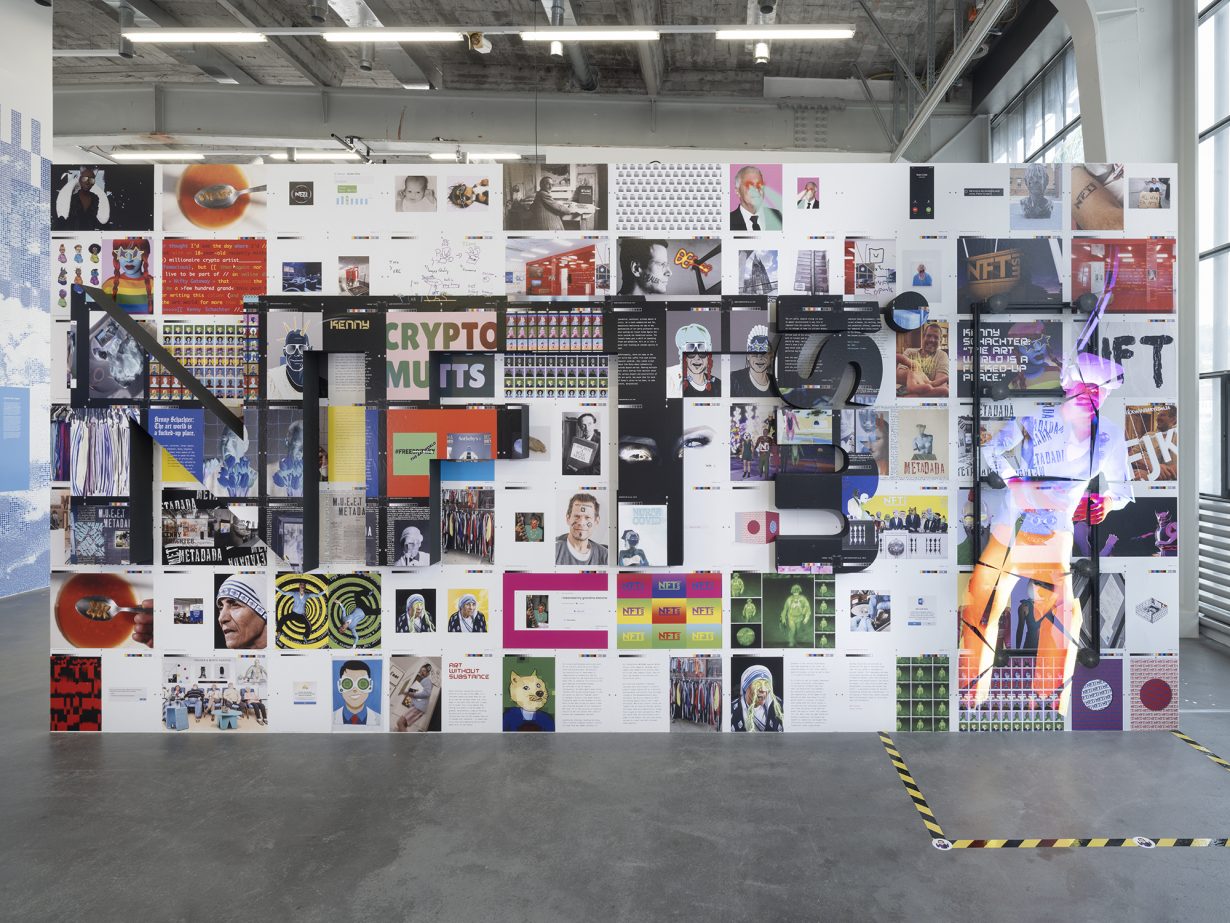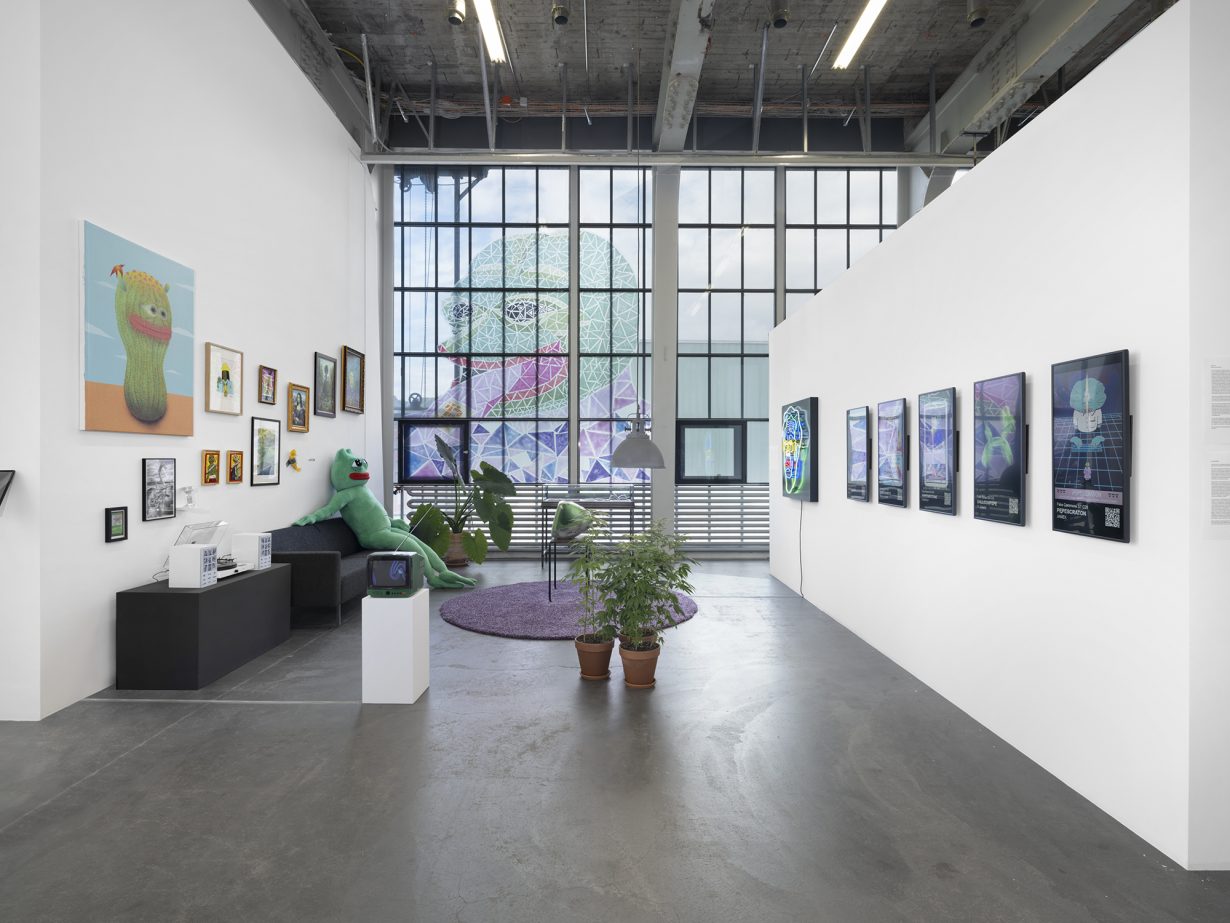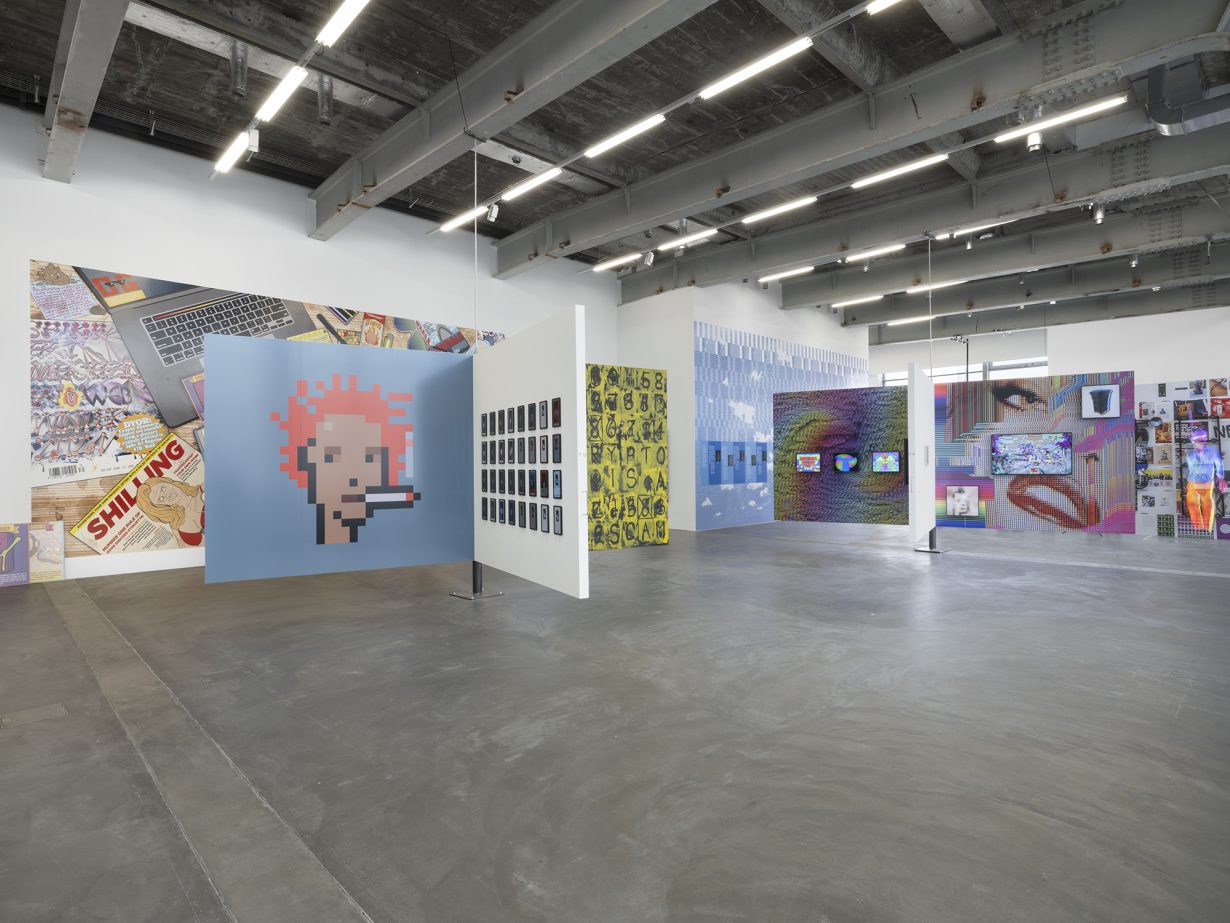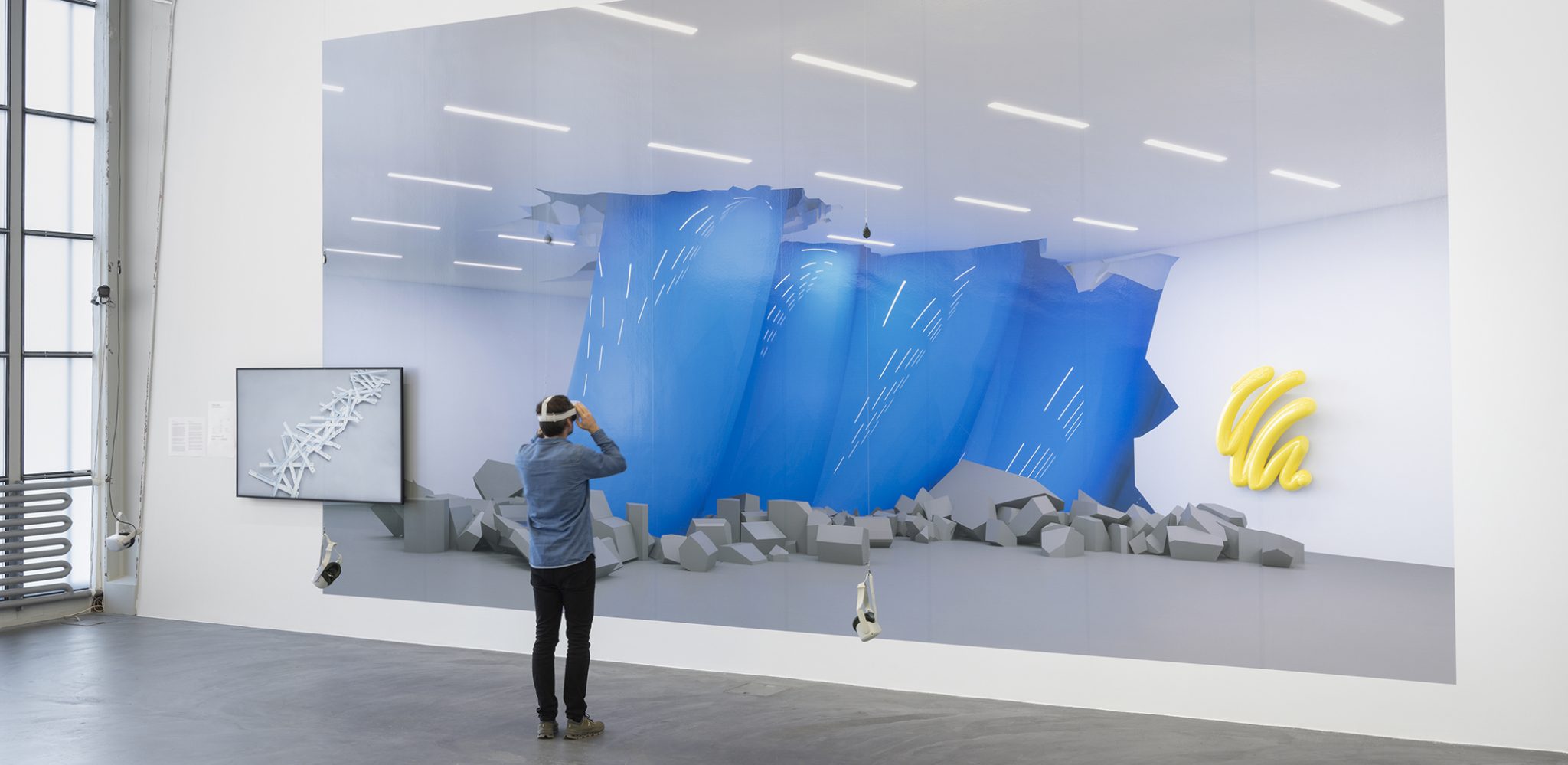At Kunsthalle Zürich, a lively review of the anarchic, generative and sometimes frenzied moment in the interplay between art, technology, pop culture and tech-utopianism
It’s been some two years since public attention was yanked towards the phenomenon of NFTs, turbocharged by the stratospheric auction sales of works by US media artist Beeple in late 2020 and early 2021. Those two years have seen the value of cryptocurrencies skyrocket, only to crash again, the get-rich hype-bubble of crypto bursting in 2022. Yet alongside this, the artistic and cultural interest in NFT, blockchain and cryptocurrency have persisted, since the critical issues that lie at the heart of blockchain speculation – decentralisation, the control of digital assets by creators and the emergence of new forms of virtual art – haven’t gone away.
DYOR (from the injunction to ‘Do Your Own Research’, in crypto parlance), put together by digital curator and gallerist Nina Roehrs, makes for a lively and thoughtful review of this anarchic, generative and sometimes frenzied moment in the interplay between art, technology, pop culture and tech-utopianism. A tour-de-force mix of informational display and visual entertainment, the show turns around two huge rotating wall-carousels (each of the eight two-sided ‘walls’ hosting a different thematic display or grouping of artists, which visitors can revolve at their whim), a zany exhibition design that cleverly stages an artistic form that, after all, is mostly experienced on little screens and in the internet, and whose conceptual intricacies are often hard to fathom if you’re not a nerdishly committed insider.

That insider aspect of the culture that spawned NFT emerges as an important theme in DYOR, since the show identifies two broadly distinct ‘scenes’ of art and artists, which have both become visible through the NFT boom – on one side a culture of crypto enthusiasts whose references are in online culture, memes, street and graphic art, and on the other artists steeped in the history of digital and net art, while also involved in current tech developments such as AI.
So although there are (thankfully) no Bored Apes on display, one enters the show via a cannabis-plant strewn ‘living room’ dedicated to perhaps one of the earliest examples of an internet meme becoming an NFT: Pepe the Frog. The boss-eyed, fat-lipped amphibian spawned an online fan community of Pepe imagemakers during the mid-2010s who had already been trading their images on Ebay before the cult of Pepe seized on the possibilities of digital ‘rarefication’ made possible by blockchain platforms. ‘Trading cards’, merch and reproductions of famous ‘rare Pepes’, both physical and digital, surround a beatifically smiling humansize plush Pepe reclining on a sofa – Mona Lisa Pepe, Satoshi Nakamoto Pepe, Homer Simpson Pepe…

The convivial absurdity of Pepe (not withstanding his brief hijacking as a mascot of the US alt-right) highlights how much the NFT boom has been rooted in online subcultures that have had little to do with the artworld’s more exclusive networks. Groups like the Dada Collective – represented on the turnstiles by a mass of user-produced images, printed up and collaged in a dizzy pileup that reaches out from the wall – bring visual artists together to cocreate drawings as ‘visual conversations’, in which artists reciprocate by imitating and developing each other’s stylistic interests. The stylistic range, from academic to self-taught, reminds the more austere artworld of a vast, quotidian culture of imagemaking among amateurs and enthusiasts that was always out there, but that networked culture has, in the last decade or so, magnified and accelerated to an unprecedented degree.
It’s to its credit that DYOR is open to the divergence between such cultural communities. Well-represented too are those artists who have forged reputations for their sophisticated, critical probing of blockchain politics of ownership and value, among them Rhea Myers’s art-contract Certificate of Inauthenticity (2020) and Sarah Friend’s Lifeforms (2021), whose cute coloured blobs ‘live’ in your NFT wallet but have to be given away within 90 days or they ‘die’. Mario Klingemann’s Botto project (2018–) fuses AI generative art with an NFT-driven aesthetic economy, where human users up-vote Botto’s images according to their collective likes, eventually minting the machine’s learned responses to their ‘taste’. The more practical flipside of these conceptual ruminations appears with those NFT artists who collectively confront the terms of the virtual economy – such as generative artist Matt Kane’s 2020 campaign to ensure artists’ secondary sales royalties became standard in NFT transactions, a benefit even now still under threat by unscrupulous auction platforms.

The border between these scenes is porous, of course; Matt Hall and John Watkinson’s 2017 CryptoPunks (all 10,000 of them) was widely feted by the exploding NFT market, while critics recognised its framing of how artistic content could be built into the code itself. Elsewhere in the Kunsthalle, on a long partition wall, the critic, ex-dealer and anarchic Artnet columnist Kenny Schachter is represented by a wallpapering of article printouts and screengrabs (and a CGI avatar of a dancing Kenny), for his part in cheerleading what he saw as the positive disruption that the NFT boom brought to the conventional artworld. Schachter’s provocation needled many in the established artworld (he’s built his reputation on being the ‘insider’s outsider’, after all), highlighting how the artworld’s usual gatekeeping had been upset by the incursion of a new set of artists and collectors previously ignored by the art market.
DYOR’s capacious take on the rollercoaster of 2021 and 2022 frames it as the peak of a decade of diverse experimentation with the potential of blockchain, and artists’ part in that speculation. Far from being a bubble burst, many of the issues raised by the blockchain debate – about digital culture, ownership, decentralisation and what we value as ‘art’ – won’t be going away soon. At the far end of the show is a VR-headset exhibition conceived by Manuel Rossner, which maps you into a version of the galleries you’re standing in, the show replaced by startling virtual ‘sculptures’ by Rossner (Spatial Painting, 2022, is a group of huge glossy blue columns apparently smashing their way through the gallery’s floor and ceiling, out into the street beyond) and, among others, Nancy Baker Cahill and Kim Asendorf (Asendorf’s glitching black-and-white monogrid 4b, 2021, flickers across a whole ‘wall’ of the Kunsthalle’s stairwell). This VR-isation of the art gallery is an ambiguous requiem for the physical artwork and the public space that gives it meaning. Ironically for all its attention to little flat digital rectangles, DYOR ends up reaffirming the cultural value of having a place to meet, look and think ‘IRL’.
DYOR at Kunsthalle Zürich, 8 October – 15 January
